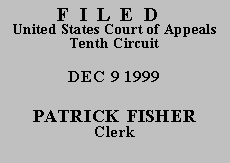

| UNITED STATES OF AMERICA,
Plaintiff-Appellee, Defendant-Appellant. |
No. 98-5206
(D.C. No. 98-CR-44-B) |
Mr. Brown first contends the district court erred in admitting into evidence a taped conversation he had with his wife while in jail. During the conversation, Mr. Brown stated, "I shouldn't even have been hanging with [Mr. Moore] since we got out." Mr. Brown objected, asserting that the latter part of the statement, "since we got out," implied his imprisonment for other unrelated charges and thereby violated Fed. R. Evid. 404(b). After the government assured the district court it would not argue Mr. Brown was previously in prison, the court overruled defense counsel's objection, holding that the statement was ambiguous regarding Mr. Brown's prior incarceration.
A district court's decision whether to admit or exclude evidence is considered harmless "unless a substantial right of [a] party is affected." Fed. R. Evid. 103(a). Such an error is one which has a "'substantial influence' on the outcome or leaves one in 'grave doubt' as to whether it had such effect." United States v. Rivera, 900 F.2d 1462, 1469 (10th Cir. 1990) (en banc). When conducting our harmless error analysis, we review the record as a whole. See United States v. Charley, 189 F.3d 1251, 1270 (10th Cir. 1999).
Assuming without deciding that admitting the latter part of the statement was an error, that error was harmless given the other evidence presented to the jury. At trial, Mr. Moore's girlfriend, Misty Fallin, testified that Mr. Moore and Mr. Brown committed the robberies and that Mr. Brown had a gun in his possession. She identified Mr. Moore and Mr. Brown in the surveillance videos taken during the two robberies. She also testified as to the clothing Mr. Brown and Mr. Moore wore during the robberies and the getaway vehicles used, which was supported by other witnesses' testimony and the video surveillance tapes. Even if admitting the taped conversation was an error, it was a harmless given this clear and overwhelming testimony. See, e.g., United States v. Oberle, 136 F.3d 1414, 1418-19 (10th Cir. 1998) (admission of Rule 404(b) evidence was harmless in light of other substantial evidence against defendant), cert. denied 119 S. Ct. 197 (1998).
Mr. Brown also challenges on appeal the admission of the first part of the statement, "I should not even have been hanging with him" as inadmissible hearsay evidence not within the exception for admissions against interest as stated in Fed. R. Evid. 801(d)(2)(A). Because Mr. Brown did not raise this objection at trial, we review for plain error. "'Plain errors' are those which are obvious and substantial, and which when viewed in light of the entire record seriously affect the fairness, integrity, or public reputation of judicial proceedings." United States v. Nall, 949 F.2d 301, 309 (10th Cir. 1991) (citations omitted). The government argues that Mr. Brown's statement reflects his regret or remorse concerning his association with Mr. Moore and is thus an admission against interest. We are not persuaded it was obvious that Mr. Brown's remorse regarding his association with Mr. Moore was other than an admission against his interest or that the admission of the statement affected the fairness of the trial or any of Mr. Brown's substantial rights. The court therefore did not commit plain error in admitting this part of Mr. Brown's statement.
Mr. Brown also challenges the false exculpatory instruction given to the jury. Mr. Brown told police he was at an unemployment office during the time period in which the April 3 bank robbery occurred. Based upon this statement, the prosecution requested and received a false exculpatory jury instruction. Defense counsel objected to the instruction, arguing that the instruction was circular by requiring the jury to find Mr. Brown guilty in order to find the statement false. Although we recognize the potential circularity problem in giving this instruction, see United States v. Durham, 139 F.3d 1325, 1332 (10th Cir. 1998), cert. denied 119 S. Ct. 158 (1998), if error occurred it was harmless in light of the abundant evidence presented against Mr. Brown. See id. (faulty jury instruction does not require reversal if error was harmless).
Mr. Brown finally argues that although each of these alleged errors may be harmless separately, cumulatively they are prejudicial. Even assuming cumulative error occurred, to be prejudicial the errors must have a substantial influence on the outcome of the case or leave this court in grave doubt as to whether they had such an effect. See Rivera, 900 F.2d at 1469. Considering the evidence against Mr. Brown, we are convinced the cumulative effect of the district court's actions, assuming them to be in error, did not have a substantial influence on Mr. Brown's convictions.
Regarding the trial court's judgment and commitment order, the government concedes it should be amended to provide for the joint and several obligation of Mr. Moore and Mr. Brown. We therefore remand this case to the district court to permit amendment of that order to provide for Mr. Moore's and Mr. Brown's joint and several responsibility.
We AFFIRM Mr. Brown's conviction and REMAND this case to the district court to amend the judgment and commitment order.
ENTERED FOR THE COURT
Stephanie K. Seymour
Chief Judge
*.This order and judgment is not binding precedent, except under the doctrines of law of the case, res judicata, and collateral estoppel. The court generally disfavors the citation of orders and judgments; nevertheless, an order and judgment may be cited under the terms and conditions of 10th Cir. R. 36.3.
**.The Honorable Dale A. Kimball, United States District Judge for the District of Utah, sitting by designation.